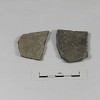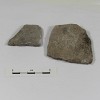
| Culture | Branch | Tradition | Ware | Type |
| Ancestral Pueblo: Southern Colorado Plateau (Anasazi) | Central Anasazi | Northern San Juan | Northern San Juan Gray Ware | Chapin Gray |
Type Name: Chapin Gray |
|
| Period: | 550 A.D. - 850 A.D. |
| Culture: | Ancestral Pueblo: Southern Colorado Plateau (Anasazi) |
| Branch: | Central Anasazi |
| Tradition: | Northern San Juan |
| Ware: | Northern San Juan Gray Ware |
First posted by C. Dean Wilson 2012
Chapin Gray was defined by Abel (1955) to refer plain gray ware forms exhibiting crushed igneous temper indicative of production in the Mesa Verde region that had been earlier described as Lino Gray (Lancaster and others 1954) or Basketmaker III plain surface (Morris 1939). This type is analogous to Lino Gray as defined for the Cibola and Kayenta traditions, Rosa Gray for the Upper San Juan tradition, and to Bennett Gray for the Chuska tradition. Chapin Gray refers to unpolished vessels or rim sherds with scraped or plain exterior surfaces. Coils used in vessel production have been completely obliterated, and enough of the sherd is present to infer that obliteration applies to the neck of the vessel as well as to the rim. Within the Northern San Juan region, this type is associated with sites dating at least as early as A.D. 575, and the type occurs in diminishing frequencies at least as late as A.D. 950. It continues to be common but the overall frequency gradually declines after the introduction of neck banded types in the late eighth century.
A wide variety of vessel forms is represented by Chapin Gray including wide mouth cooking or storage jars, ollas, dippers, bowls, seed jars, and gourd jars. The range of forms is much wider prior to the middle eighth century, after which many of the forms, such as cooking or storage jars and seed jars begin to be replaced by both other gray ware types and other wares. Sooting and wear patterns commonly reflect use for cooking, although a range of uses are certainly reflected. After the mid ninth century, Chapin Gray is increasingly restricted to forms such as ollas, miniatures, and effigies. Fugitive red pigment often occurs on the exteriors of Chapin Gray forms other than cooking jars. A wide range of pastes and temper are also present in plain utility wares from various areas of the Northern San Juan region (Wilson and Blinman 1995). Tempers from Chapin Gray sherds from a particular locality will often include a wide range of sedimentary and igneous rocks. Size of temper also varies, reflecting variability in both selection and processing. This overall variability reflects both the wide distribution of Basketmaker III sites across different resource zones as well as early experimentation with appropriate clay and temper recipes. Temper is often visible through the surface often creating a pitted effect. Surface color is commonly light to dark gray, but may be tan, brown, to reddish. Pastes may fire to a very wide range of colors when exposed to an oxidation atmosphere. Chapin Gray is only recognized for rim sherds, and the majority of sherds deriving from Chapin Gray will be assigned to Plain Gray. Sherds derived from the painted portions of Unpolished Black-on-white types (such as Chapin Black-on-white) may sometimes be assigned to Chapin Gray.
References:
Abel, Leland J.
1955 San Juan Red Ware, Mesa Verde Gray Ware, Mesa Verde White Ware and San Juan White Ware, Pottery Types of the Southwest: Wares 5A, 10A, 10B, 12A. Museum of Northern Arizona Ceramic Series 3B, Flagstaff.
Lancaster, James A.; Pinkley, J. M; Van Cleave, P. F.: and Watson Don.
1954 Archaeological Excavations in Mesa Verde National Park, Colorado, 1950. Archaeological Research Series, No.2, National Park Service, Washington D.C.
Morris, Earl H.
1939 Archaeological Studies in the La Plata District in Southwestern Colorado and Northwestern New Mexico. Carnegie Institution of Washington, Publication No. 519, Washington, D.C.
Wilson, C. Dean, and Eric Blinman
1995 Ceramic Types of the Mesa Verde Region. In Archaeological Pottery of Colorado: Ceramic Clues to the Prehistoric and Protohistoric Lives of the State's Native Peoples, edited by R.H. Brunswig, B. Bradley, and S.M. Chandler, pp. 33-88, Colorado Council of Archaeologists Occasional Papers 2, Denver.
Related Photos
 © New Mexico Office of Archaeological Studies, a division of the New Mexico Department of Cultural Affairs.
© New Mexico Office of Archaeological Studies, a division of the New Mexico Department of Cultural Affairs.
The Center for New Mexico Archaeology
7 Old Cochiti Road
Santa Fe, NM 87507
505-476-4404
Fax: 505-476-4448






